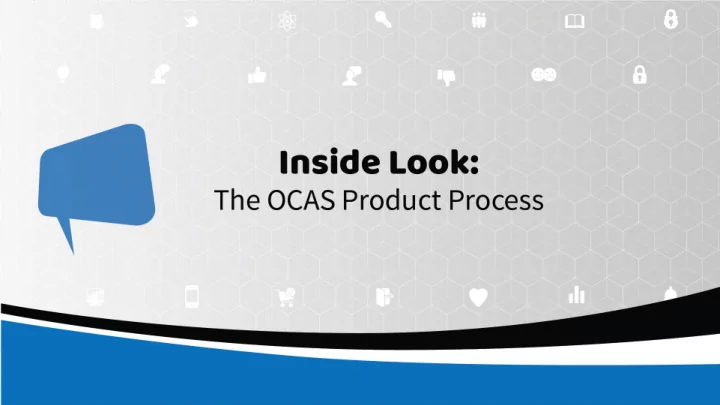

Hello! MEET YOUR PRESENTERS Mike Williamson Raghav Sandhu Manager, Product Management Product Manager 10 years of experience in management 5 years of experience in consulting, digital product consulting, digital product development, and development and innovation in various Canadian innovation across the UK, Australia, and Canada. companies. Responsible for Product Management at OCAS. Responsible for the Domestic product line at OCAS. 2
Today’s Session WHAT WE’LL COVER Why do you need a Product Process? 1 What is our Goal when Developing or Enhancing Products? 2 What Happens in the Process? 3 Experience a Product Process Challenge 4 4 Summary 5 3
Why do you need a Product Process? WE DISCOVER PRODUCTS AND SERVICES THAT ARE DESIRABLE, VALUABLE & FEASIBLE START HERE Must be desirable Must be feasible Must be valuable (Note: at OCAS ‘product’ = a product or service) 4
What is our Goal? WE AIM TO MAXIMIZE THE VALUE DELIVERED TO CUSTOMERS…ONE ITERATIO N AT A TIME Minimum Product Viable Product Vision 5
What Happens in the Process? USER-CENTERED DESIGN Source: citl.illinois.edu, 2018 6
Product Process Challenge HOLD ONTO YOUR SEATS… 7
Today’s Activity AN EVERYDAY SITUATION Think back to your routine grocery store experience from start to finish. Visualize all the steps you take from parking, entering the store, shopping, and checking out. How might we improve the grocery shopping experience? 8
Let’s Get Started STEP INTO THE WORLD OF THE OCAS PRODUCT TEAM Define: Break out into pairs to interview a grocery store user Empathize: Define the main problems faced by those users Ideate: Join up with another pair to ideate potential solutions Prototype: Prototype your solution and test it with the audience 9
1. Empathize with Users WHO ARE YOUR USERS?
1. Empathize with Users 10 mins WHAT DO USERS NEED? • Objective: Speak with real users to learn about their needs Tool: Empathy Map • Task: Split up into pairs and interview one person as a grocery store user • Approach: Ask open-ended questions and take notes: 1. Tell me about the last time you went grocery shopping? 2. How did you feel when…? 3. What did you see/hear/think/say/do…? 4. What is the most frustrating thing about…? 5. What do you wish you could do that you can’t do today? 6. Can you give me an example? 7. Why? or Why not? 11
2. Define the Problem 5 mins WHAT PROBLEMS DO USERS FACE? Tool: Interview Notes • Objective: Clearly define the user’s main problems • Task: As a pair, identify 2 - 4 problems in your own words • Approach: Combine potential needs and insights from your interview notes: 1. Checkout is a slow process that makes users feel frustrated 2. The shopping experience is chaotic and people leave feeling exhausted 3. Shopping carts are not returned and end up damaging parked cars 12
3. Ideate Potential Solutions 10 mins WHAT POSSIBLE SOLUTIONS ARE OUT THERE? • Objective: Explore potential solutions to the problem Tool: Write or Sketch Ideas • Task: Combine with another pair, pick one problem to focus on and generate ideas that could solve that problem • Approach: 1. Agree on the problem you want to solve 2. ‘Start solo’ to generate ideas 3. Share your ideas with the group 4. Choose one idea to prototype 13
4. Prototype & Test your Solution 10 mins WILL OUR SOLUTION WORK? • Objective: Create a representation of your solution to share Tool: Sketch of Solution with users for feedback (e.g. Reusable Bag Brag Flag) • Task: Create a sketch (‘prototype’) of your solution and gather feedback • Approach: Share the sketch of your solution and we will ask other groups the following questions to get feedback: 1. What did you like? 2. What would you improve? 3. Do you have any questions? 4. What new ideas does this trigger? 14
In Summary START WITH EMPATHY AND ITERATE TOWARDS THE BEST SOLUTION TO THE PROBLEM 14
Recommend
More recommend